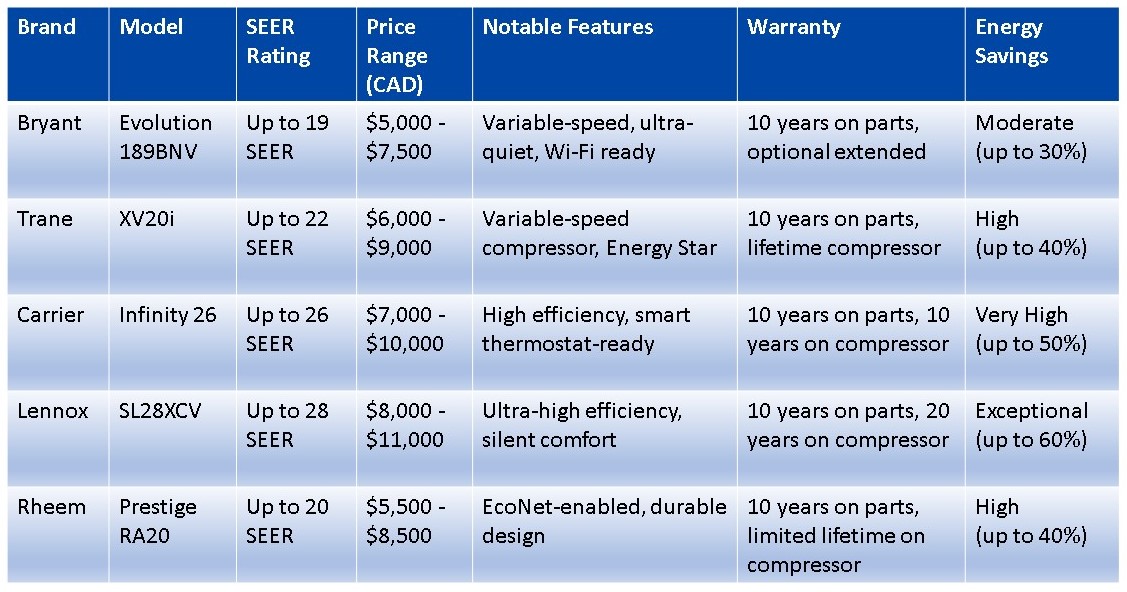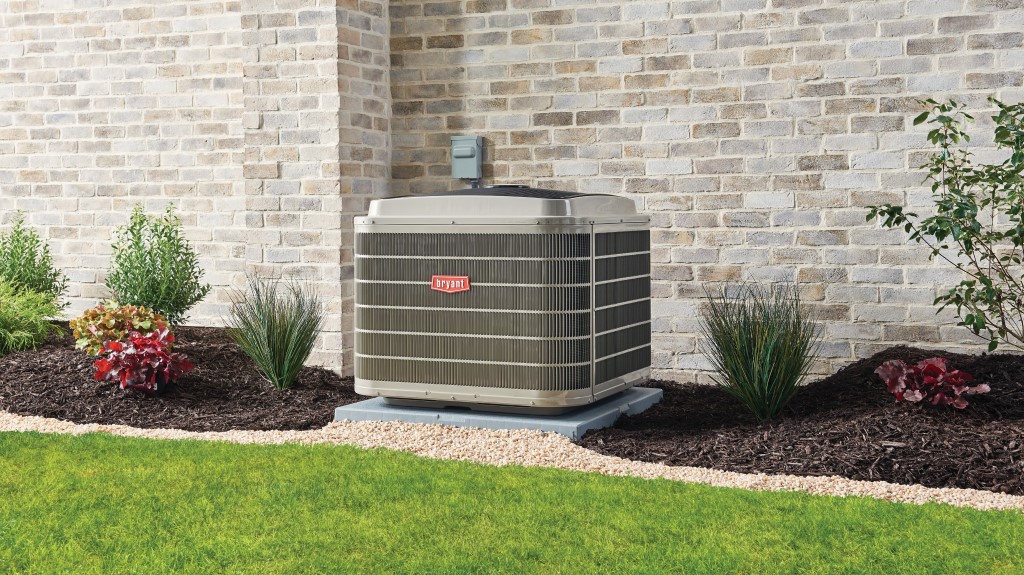The cost to replace an air conditioner in Toronto, Ontario, typically ranges from $3,000 to $7,000, depending on factors like the unit’s size, efficiency, brand, installation requirements, and whether you choose additional upgrades (e.g., ductwork). In this blog, Ideal Heating & Cooling will explore and compare the factors that impact the price tag of your next air conditioning unit.
1) How Much Does It Cost To Replace an Air Conditioner?
2) Factors Affecting Cost To Replace Air Conditioner in Toronto
3) A Cost Comparison Chart of Air Conditioning Units
For a more specific estimate tailored to your needs, consult your Ideal HVAC provider. And, if you are looking for air conditioning service, consider hiring our HVAC technicians.
What Is Cost To Replace Air Conditioner in Toronto?
1) How Much Does It Cost To Replace an Air Conditioner?
Replacing an air conditioner in Toronto can cost between $3,000 and $7,000, influenced by factors such as the unit’s size (measured in BTUs), energy efficiency ratings (SEER), and the brand. Installation complexity, such as modifications to ductwork or electrical systems, also impacts pricing. High-efficiency or environmentally friendly models typically cost more but can lower long-term energy bills. Additional factors like rebates for energy-efficient models and warranty options may further influence the overall cost.
We’ll cover these contributing factors next, but keep in mind that is always best to speak with your local HVAC specialists for specific estimates and advice.

Larger homes require higher-capacity HVAC systems which in turn increases the cost of your air conditioner.
2) Factors Affecting Cost To Replace Air Conditioner in Toronto
The cost of replacing an air conditioner in Toronto depends on several key factors:
- Unit Size (BTUs): Larger homes require higher-capacity systems, which cost more.
- Energy Efficiency: Higher SEER-rated models are pricier but offer better long-term savings.
- Brand and Features: Premium brands and advanced features (e.g., smart controls) add to the cost.
- Installation Complexity: Modifications to ductwork or electrical systems increase labour costs.
- Government Rebates: Incentives for energy-efficient models can offset costs.
- Additional Upgrades: Extras like thermostats or extended warranties may increase expenses.
Next is a detailed breakdown of the factors affecting the cost of replacing an air conditioner in Toronto.
Unit Size (BTUs)
The cooling capacity of the AC, measured in BTUs, must match the home’s size. Larger systems for bigger homes are more expensive. Keep in mind that a bigger A/C unit is not always better. An oversized air conditioner can cool a space too quickly, leading to short cycling, inefficient operation, uneven cooling, and inadequate dehumidification. This can increase energy costs and reduce comfort. Properly sizing the unit to your home’s cooling load is crucial for optimal performance and energy efficiency.
To calculate the general BTU requirements for your air conditioner yourself, follow these steps:
- Determine Total Area: Measure each room’s square footage (length × width) and sum up the areas.
- Use a BTU Rule of Thumb: Multiply the total square footage by 20 BTUs per square foot.
- Adjust for Home Factors: Add ~10% for sunny rooms, subtract ~10% for heavily shaded areas, and add BTUs for kitchens and spaces with high ceilings.
For example, a 1,000 sq. ft. home (1,000 × 20) means you will need a unit with 20,000 BTUs. While you can use this basic calculation, HVAC professionals use calculations like Manual J to determine the correct size based on your home’s square footage, insulation, and climate.
Energy Efficiency (SEER)
Systems with higher Seasonal Energy Efficiency Ratios (SEER) are more costly upfront but save on energy bills. These systems are more costly because they use advanced technology to improve energy efficiency. Features like variable-speed compressors, better insulation, and more efficient heat exchangers increase manufacturing costs. These systems reduce energy consumption and lower utility bills over time, offering long-term savings, which justifies their higher initial price. Additionally, many high-SEER units comply with stringent energy standards and may include premium features such as quieter operation or smart controls.
Brand and Features
Premium brands with added features like variable-speed fans or smart thermostats tend to have higher prices. Some examples of premium air conditioner brands known for their high efficiency and advanced features include:
- Byrant
- Trane
- Carrier
- Lennox
- Rheem
These brands offer systems with high SEER ratings, quiet operation, and advanced features like smart thermostats, making them a popular choice for those looking for long-term energy savings and premium performance.
Discover what people are saying about these 5 brands - and remember that Bryant and Carrier are considered "twins" in the HVAC industry.
Installation Complexity
Costs increase if installation requires additional labour, such as upgrading ductwork, electrical connections, or relocating the unit. A more complex installation of an air conditioner could arise due to factors like having old or incompatible ductwork. If ducts need upgrading or resizing for proper airflow, installation becomes more involved. Another reason installation may be more complex is if you need electrical upgrades. New units may require additional electrical work, like a new circuit or panel. Other issues arise like space limitations or multi-zone system requirements. Tight or difficult-to-access spaces can make installation more challenging. Installing multiple indoor units or complex ductless systems can increase labour. All of these factors can add to both time and cost.
Government Rebates and Incentives
Rebates for energy-efficient models, offered by provincial or federal programs, can reduce overall costs. Contact Ideal Heating & Air Conditioning to ask about current rebates and incentives. Alternatively, you can consider financing and rentals.
Additional Upgrades
Optional enhancements, such as smart thermostats, air purifiers, or extended warranties, can raise the total expense.
As you can see, there are a variety of factors influencing the cost of an air conditioning unit. Even the layout and design of your home, including multi-story layouts or challenging installation areas, can impact labour and installation fees. For that reason, we suggest you do some research and call an HVAC technician for professional advice.
3) A Cost Comparison Chart of Air Conditioning Units
Here’s a cost comparison chart of five popular air conditioning units in Canada. Prices include estimated unit costs and installation.

4) Frequently Asked Questions
Below we’ve included some common questions customers ask when considering cost to replace air conditioner in Toronto. If you have a question that is not listed here, don’t hesitate to reach out.
The size of the air conditioner depends on your home’s square footage, insulation, ceiling height, and climate. As a general guideline, you need about 20 BTUs per square foot. HVAC professionals use detailed calculations (Manual J) to determine the correct size for maximum efficiency and comfort.
Air conditioners typically last 12 to 15 years (and even up to 20 years), depending on maintenance and usage. If your unit is older, inefficient, or frequently breaks down, replacing it with a newer, more efficient model can save on energy and repair costs.
Yes, high-efficiency air conditioners with higher SEER ratings typically cost more upfront but can reduce energy bills by up to 60% over time. They also often qualify for rebates and offer enhanced comfort with quieter operation and better temperature control.
Yes, many HVAC companies offer financing options, allowing you to spread the cost over monthly payments. Interest rates and terms vary, so it’s essential to shop around and ask about available plans. Contact us to learn more.
Installation usually takes 4 to 8 hours, depending on the system’s complexity and any additional work required (e.g., duct or electrical upgrades). Larger or more complex installations may take longer.

If you’re looking for reliable air conditioner replacement or servicing in Toronto and the surrounding areas within the Greater Toronto Area, Ideal Heating and Air Conditioning is your go-to choice. With a commitment to quality, we offer top-rated brands, expert installation, and exceptional customer service to ensure your home stays cool and comfortable. Whether you need a new energy-efficient system, routine maintenance, or other HVAC services, Ideal provides customized solutions tailored to your needs. Contact us today and experience the difference of working with trusted HVAC professionals in Ontario!
